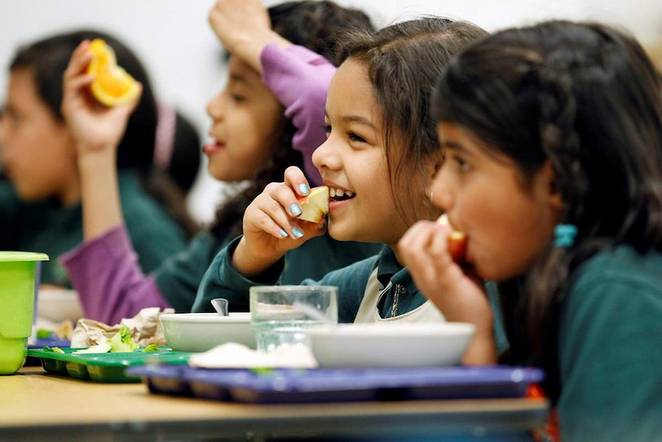Source: treehugger.com
Published: February 22, 2017

CC BY 2.0 US Dept of Agriculture
The Oakland Unified School District has concluded a two-year experiment and discovered savings, both environmental and financial.
The closest thing we’ve got to a silver bullet solution for climate change is the reduction of meat and dairy in our diets. At no extra cost, it’s possible to shrink one’s carbon footprint by a significant amount, simply by choosing to eat more plant-based foods. And yet, while many cities and municipalities lead the way with innovative plans for climate change mitigation, shifting institutional diets to be more vegetable-centric is rarely discussed.
In an interesting two-year experiment to address this odd gap, environmental advocacy group Friends of the Earth (FOE) partnered with the Oakland Unified School District (OUSD) in California to see how reducing meat and dairy in school cafeterias would affect the school district’s carbon footprint, water usage, and cost savings. The results were published this month in a report called, “A Recipe for Combating Climate Change” (pdf).
Over two years, OUSD reduced the amount of animal products served in schools by 30 percent. The meat it served in reduced quantities was purchased from Mindful Meats, a northern California company that sources from organically-raised, spent dairy cows. The environmental savings were significant, described in the image below:

© FOE
At the same time, the amount of produce purchased locally went up by 10 percent, while saving the district $42,000 in food costs. Students weren’t unhappy with the new veggie-centric items on the menu; in fact, they reported increased satisfaction with the healthy, regionally-sourced meals. It seems that kids are happy to eat bean tostadas, beef-mushroom burgers, and bean chili instead of hot dogs – imagine that!
OUSD is not the only organization that has managed to save significant amounts of money by reducing meat consumption. The report mentions that four Bay Area hospitals save $400,000 each year by incorporating more vegetarian dishes into their menus, and the Maricopa County Jail in Arizona saved $817,000 in one year by switching inmates to an entirely meatless diet. By introducing Meatless Mondays, New Jersey’s Valley Hospital saved nearly $50,000 in a year.
What’s so interesting about this climate mitigation strategy is that it costs no extra money. Unlike installing solar panels on one’s home, investing in an electric car, planting trees, renovating to make a building more energy efficient, buying carbon offsets, etc., a plant-forward dietary change will ultimately save money while reducing one’s footprint quickly.

© FOE
As Friends of the Earth points out, Americans could benefit greatly from doing this:
“High consumption of red and processed meat is associated with increased risks of diet-related diseases (heart disease, diabetes, and cancer) that cost our nation hundreds of billions of dollars a year. On average Americans eat 50 percent more meat than is recommended by USDA dietary guidelines and only 20 percent eat the suggested amount of fruits and vegetables.”
There’s no reason why other school districts could not implement OUSD’s successful program, which isn’t even that radical. The report shares resources like the Meatless Mondays K-12 Toolkit, a school food recipe book, and links to organizations such as Forward Food and Lean and Green Kids that can help.
It’s time for institutions and policy makers to stop ignoring the potential power of a meat-reduction strategy for fighting climate change.
